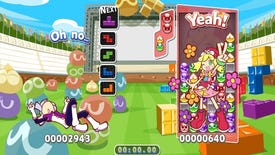Puyo Puyo Tetris is a history lesson in competitive puzzles
New Testaments
New Testaments is a monthly column in which Amr Al-Aaser presents an overlooked modern game and explicates its best ideas.
After several years trapped in a Tetris licensing hell, Puyo Puyo Tetris finally appeared on PC earlier this year. Developed by Sonic Team, the game is a reflection of the long histories of both franchises. Each game began quietly as a PC title, evolving through consoles and arcades before finally returning to the PC this year for an incredible competitive collab. It’s one of the best competitive puzzle games made, and, if I’m real, a great fighting game as well. But how did these two titans come to such an unlikely and dramatic clash?
Puyo Puyo began humbly, as a spin-off of Compile’s Madou Monogatari dungeon crawler RPGs for Japanese computers. The Puyos, who were basic enemies in the RPGs, became squishy blocks that burst when combined in sets of four. The initial version of Puyo Puyo was a solitary pursuit; the chaining system (which caused Puyos above a cleared set to drop and chain into a new set) and two player mode was already in place, but like Tetris, it was mostly an endless score chase.
It wasn’t until Complie’s arcade collaboration with SEGA that it took off. Inspired by the success of fighters like Street Fighter II, Puyo Puyo switched to a competitive focus. The chain tactics of the original turned into a deadly weapon that rained “garbage” blocks onto other players, disrupting their board. Victory required balancing set ups for large chains with smaller, disruptive ones, and - in later versions - being able to counter and reverse incoming garbage. This made it an exhilarating game unlike other puzzlers, and became a sensation that culminated in a championship tournament for Puyo Puyo 2, with tons of spectators coming to witness high level competition.
Despite Japanese success, Puyo Puyo never made a big splash outside its home country. English speaking countries got drastically reworked versions for consoles in the form of Dr. Robotnik’s Mean Bean Machine and Kirby’s Avalanche. PC players didn’t get translations of the the PC ports until Puyo Pop Fever, having to settle for a Windows adaptation called Qwirks (presented by Tetris peddlers themselves, Spectrum Holobyte), and the thoroughly unappetising sounding Amiga clone, Super Foul Egg.
Tetris's history, on the other hand, you probably already know. Designed by Alexey Pajitnov for Soviet computers, it was unofficially licensed by Spectrum Holobyte, owned by the Soviet government itself, and cloned and ported to every system possible, going through several copyright kerfuffles before finally returning to Pajitnov.
What Puyo Puyo Tetris foregrounds is the competitive history of Tetris, and the quiet refinements happening over the years. In fact, I initially approached Puyo Puyo Tetris by trying to create Tetrises as fast and efficiently as possible, but it quickly became clear that wouldn’t cut it. That’s when I discovered the range of techniques added to the Official Tetris Guidelines.
Suddenly I was in deep, analyzing and imitating video demos, the same way you’d practice combos and counters in a fighting game. There were strategies for creating wells that set up cascading combos of line clears. Tech that exploited modern piece randomizers for a chance to clear everything from the board immediately and cover the opponent in massive lines of garbage. Or the T-spin, which uses the “kick” that pushes pieces of other pieces and wall boundaries to snap T shaped pieces into otherwise impossible places.
Competitive boards look nothing like the clean, organized layouts of regular Tetris games, but like absurd dungeon layouts, stacked to create ridiculous corridors to sneak combos and triple T-spins through. It’s like playing Chess casually for your entire life, knowing only the basics, then becoming abruptly aware of the hundreds of years of theory and high level play that exist. This had all been developing for years, and nobody I knew had known about it until now.
In that way, Puyo Puyo Tetris acts as the perfect gateway into this history, bringing in people with the familiarity of Tetris, then introducing them to both the colorful Puyo Puyo, and the lesser appreciated nuances of Tetris’ evolution.
This mashup comes to a climax in Puyo Puyo Tetris’ Swap Mode, a desperate competition where you play both games, one board at a time, while a timer counts down the seconds until you’re forced into changing games. Chains can be comboed between boards as well, meaning you can set up a line clear on a Tetris board, then combo it into a chain of Puyos for more devastation. Two boards also means that if you can hold off in one until the swap, you can catch a break while you attempt a counteroffensive on the other board.
Every time I play Swap it absolutely breaks my brain. The stress of moving between two disparate styles is overwhelming. It’s hard enough to play one puzzle game well, let alone two. But each time I pick up the pieces of my broken brain I’m able to reassemble them into a slightly more efficient puzzle solving machine, and able to appreciate the nuances a bit more.
I’ve a better appreciation of each individual game as well, able to enjoy each version of Tetris or Puyo Puyo for the different elements it brings to the table. I can appreciate what previously felt identical iterations of Tetris with fresh eyes, and Tetris as a whole feels like an entirely new game. And on the Puyo Puyo side, I’ve now countless years of games to catch up on, armed with my new knowledge. That’s a reward in of itself, and it’s all thanks to Sonic Team’s brilliant little puzzle mashup.















